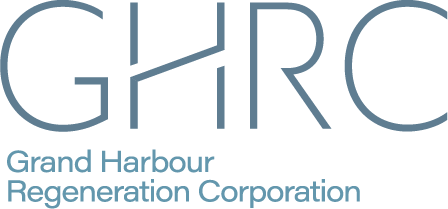Project Description
In a bid to improve connectivity between the Marsamxett ferry landing area and Marsamxetto Road (Mandraggio area), GHRC has conceptualized a project to construct a vertical access facility within this all-year-round popular area. Throughout the years numerous plans were drafted to create this connection, however, due to technical and financial reasons the project was never delivered. This was until 2018 when the initiative was approved to be included in the European Union-funded project ERDF.06.996 Regeneration of Marsamxett Project, hence feasible and technical studies could be entailed.
It is envisaged that the thirteen-passenger lift will be fully operational in 2025, and hence a 20 seconds journey will reduce if not eliminate any encumbrance to pedestrians who presently need to walk up a steep hill to reach Valletta from the Marsamxett ferry landing area.
The site contains multiple layers of history starting from the oldest known layer being the quarry, which was used during the construction of Valletta in the 16th century, up until the most recent layer of the 20th century Manderaggio neighbourhood.

Marsamxett
After the Great Siege Grand Master Jean Parisot de Valette decided that the knights should build a fortified city with two protective harbours: the Marsamxetto Harbour and the Grand Harbour. Upon realising that the former was exposed to strong prevailing winds and currents, the knights focused their main protective measures towards the Grand Harbour.
The side of Marsamxett Harbour in Valletta started to be known as the Marsamxetto Ferry Landing after a steam ferry service was introduced between Sliema and the Grand Harbour. Although through different marine technology, the ferry service is still running to the present day.
THE PEACOCK GARDEN OPTION
A feasibility study, carried out by a renowned architectural firm, shortlisted four possible options where the vertical access could be constructed. Various parameters were assessed and subsequently, the report concluded that the most feasible preference would be the Peacock Garden option. Since the entrance and exit to the lift are both adjacent to an existing vehicular route, there is the possibility to integrate a loading/unloading zone for taxis and other public transport into Valletta.
TECHNICAL ASPECTS
The implementation stage
The project was segmented into three phases i.e. the excavation and structural reinforcement stage, the installation of the passenger lift, and the installation of services and finishes.

The first phase comprised in extending the excavation of an existing pit at Peacock Garden level. This entailed the removal of existing soil level and recovery of archaeological artefacts. Throughout this process, an array of stainless-steel rods was driven into the existing soil and rock to increase structural sturdiness while seven annular beams were constructed to withstand existing forces. Once this phase was completed, the underlying rock was diligently excavated to the required level and size to form the vertical lift shaft. In conjunction, a twelve-meter tunnel was excavated to enable a horizontal connection between the ferry area and the vertical access.
The subsequent phase would include the erection of a steel structure that should serve as a hoistway to the passenger lift, the installation of the lift cabin and motorization, and the construction of a glazed enclosement. Presently the tender document is being drafted and a call for bids is expected to be published by the end of June 2024.
The final stage will include the installation of additional mechanical and electrical services, ELVs, paving works and street furniture at Peacock Garden and the ferry landing area.
Presently the final stages of the first phase are being attained.


